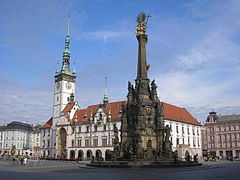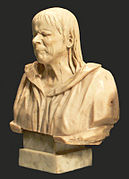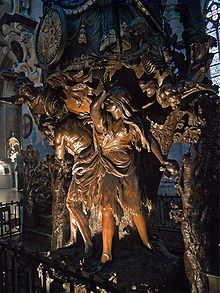Baroque sculpture
Baroque sculpture is the historiographical denomination of the sculptural productions of the Baroque period (from the beginning of the XVII century in the middle of the 18th century century).
Its general characteristics are:
- Naturalism, that is, representation of nature as it is, without idealizing it.
- Integration in architecture, which provides dramatic intensity.
- The compositional schemes free of geometry and the balanced proportion proper to the sculpture of the full Renaissance. Baroque sculpture seeks movement; it is dynamically projected outward with complex tension lines, especially helical or serpentine, and multiplicity of planes and views. This instability is manifested in the concern of characters and scenes, in the breadth and ampulosity of clothing, in the contrast of textures and surfaces, sometimes in the inclusion of different materials, all of which produces strong light and visual effects.
- Representation of the nude in its pure state, as a frozen action, achieved through asymmetric composition, where diagonals predominate and serpentine, the biased and oblique poses, the short and the diffuse and intermittent contours that direct the work towards the spectator with great expressivity.
- Despite the Baroque's identification with a "art of the Counter-Reformation", suitable to the feeling of popular devotion, baroque sculpture, even in Catholic countries, had a great plurality of themes (religious, funeral, mythological, portraits, etc.).
- The main manifestation is the statuery, used for the ornamentation of interior and exterior spaces of the buildings, as well as the open spaces, both private (gardens) and public (places). The sources were a sculptural type that settled very well with the baroque style. Particularly in Spain, they had an extraordinary development the imagery and the altarpieces.
Other features. Common characteristics of Baroque architecture:
- He maintained the symmetry of Renaissance architecture.
- Torcid columns, often only decorative and not supportive as in ancient Greece and Rome.
- Curved lines abound more than straight lines.
- Highly ornamented decoration details.
- Sensation of movement in forms.
- Towers and domes or domes.
- Abundance of windows.
- Structured buildings in large ships
- Optical illusions
- Integration of architecture and painting
- Interiors decorated with magnificent frescoes in skyscrapers and walls.
Baroque sculpture in Spain
The evolution of Baroque sculpture in Spain had its own development hardly influenced by foreign schools since neither the most outstanding sculptors traveled abroad as they had done in the previous century, nor were many foreign sculptors who worked in Spain, nor the importation of works was significant.
The theme is almost exclusively religious, both for private and institutional commissions, for private and public devotion, in images of all kinds, from small devotional pieces to large baroque altarpieces and processional steps. The imagery stands out with a lot, being the most used material wood, following the Hispanic tradition, with polychromy and the stew technique, both in round shape and in relief. Great verisimilitude is sought, usually described as "realism" or "naturalism"; the images appear with all kinds of hairpieces, natural hair, glass eyes and tears, and rich garments of royal fabric. The purpose is to provoke a deep religious emotion in the viewer. The stone carving is usually limited to the sculptural decoration of the portals (facades-altarpiece). Monumental statuary only appears in the area of the Court (the bronze equestrian portraits of Felipe III and the equestrian statue of Felipe IV were commissioned in Italy, from Pietro Tacca, and there are also models of an equestrian statue of Carlos II, a similar monument for Carlos II, by Giacomo Serpotta). Mythological and secular themes are absent.
Different stages can be recognized in Spanish Baroque sculpture. At the beginning of the century, the passage from Mannerist Romanism to Baroque Naturalism was observed, which would evolve throughout the century seeking greater effectiveness through gestures, postures, or the use of hairpieces. This greater baroque style is clearly observable in the architecture of the altarpieces. Already in the second third of the XVIII century, the influence of the Rococo gave rise to more amiable works of softened drama. On the other hand, there are two main schools: the Andalusian school and the Castilian school.
In the Castilian school, centered on Valladolid and Madrid, a tremendously realistic sculpture is presented, whose hallmarks are full size, pain and cruelty with abundance of blood, deep dynamism, caricature of evil characters, intense modeling and faces with strong expressiveness. Sculptors of this school are Francisco del Rincón, the Galician Gregorio Fernández (1576-1636), Juan de Ávila, his son Pedro de Ávila, Luis Salvador Carmona (all of them belonging to the area of Valladolid), and in Madrid Juan Sánchez Barba and the Portuguese Manuel Pereira. In Toro, the workshop of Sebastián Ducete and Esteban de Rueda creates a sculpture influenced by Juni and Fernández, but with a less dramatic theme and a more friendly tone.
On the other hand, in the Andalusian school, with focuses in Seville (Sevillian school), Granada (Granada school) and Málaga (Málaga school), they avoid exaggeration, idealization, serenity and beautiful and balanced images predominate with a smooth modeling. The great sculptors of this school are Juan Martínez Montañés, Alonso Cano, Pedro de Mena, Fernando Ortiz, José de Mora, Pedro Roldán, his daughter Luisa Roldán (la Roldana), Juan de Mesa, José Risueño, Bernardo de Mora, Andrés de Carvajal and Pedro Duque and Cornejo, José Montes de Oca.
The arrival of the Bourbons in 1701 led to a change of tastes at court. French and Italian artists were called upon to decorate the royal palaces and gardens, although the religious imagery retained its uniqueness.
The Neapolitan Nicolás Salzillo and his son Francisco Salzillo developed their activity in Murcia, where they developed a style in transition towards rococo and neoclassicism by not delving into the dramatic aspects of the scenes, delving into naturalistic concepts and idealized beauty, beginning the Murcian school that would continue in later authors such as Roque López or Juan Porcel. The Spanish Late Baroque or Rococo of the first half of the XVIII century has a very ornate style, corresponding in altarpieces and architectural elements (such as the covers) to the Castilian Churrigueresque (the Churrigueras, Pedro de Ribera, Narciso Tomé), in Galicia on the façade of the Obradoiro de Santiago de Compostela (Fernando de Casas Novoa), or in Valencia on the doorway of the Palace of the Marqués de Dos Aguas (Ignacio Vergara).
With the reign of Carlos III, neoclassical taste prevailed. In 1777 the Royal Academy of Fine Arts of San Fernando assumed the approval of the projects for the altarpieces, dictating the substitution of polychrome wood for "marble and suitable stones" The urban transformation of the city of Madrid, which can be compared to baroque fountains and perspectives, was carried out following the new style, in the second half of the century XVIII (Paseo del Prado, fountains of Neptune and Cibeles).
Baroque sculpture in Latin America
In Spanish America, the Andalusian-influenced baroque was enriched by the influence of indigenous traditions. Together with the continuous importation of sculptures and altarpieces from Sevillian workshops, the arrival of sculptors from Spain and the emergence of Indian and mestizo artisans produced the development of regional schools, among which those of Guatemala and Quito stand out in sculpture, and in the construction of altarpieces those of Mexico and Peru. The construction of the choir stalls of churches and cathedrals produced outstanding examples in Lima and Cuzco.
In Quito, Bernardo de Legarda and Manuel Chili Caspicara stood out. His workshops exported imagery to the whole of South America and even to Spain. In Peru we must name the carvers Juan Tomás Tuyro Túpac, the sculptors Pedro de Noguera and Martín Alonso de Mesa who worked in Lima, Gaspar de la Cueva who did it in Potosí and well into the century XVIII, to Baltazar Gavilán. In New Spain, José Antonio Villegas Cora was the most prominent sculptor in Puebla, and among Guatemalan sculptors we can mention Mateo de Zúñiga.
Baroque sculpture in Italy
In Italy, considered the cradle of Baroque art, the sculptor Gian Lorenzo Bernini stands out, who perfectly masters the technique he learned from his father Pietro Bernini, a Mannerist sculptor, and the study of classical and Renaissance models. His figure dwarfs all other artists, and he was considered the Michelangelo of the XVII century . He used to represent the figures in his works at the moment of maximum tension and to use the nude in his compositions. Bernini is the interpreter of the Catholic Counter-Reformation, of the triumphant Church and its glorification. He possesses strong Hellenistic influences. His sculpture is characterized by compositional theatricality, which he resolves in scenes. A great architect, he puts sculpture at the service of architecture, creating scenic spaces in the city of Rome. He seeks emotional effects in order to move, for which he uses foreshortening and violent and unbalanced positions. It has mythological works (Apollo and Daphne, fountain of the Four Rivers), religious (baldachin of Saint Peter, Ecstasy of Saint Teresa) and portraits (busts of Luis XIV, 1665, and Cardinal Borghese, 1632).
Alessandro Algardi was a great portrait painter of kings, popes, aristocrats and bourgeois, who used a more classical aesthetic. Nicolás Fumo and Giuliano Finelli (author of the statues of the counts of Monterrey in the Convent of the Augustinians in Salamanca) worked in Naples; and in Tuscany Pietro Tacca, who was in charge of the bronze equestrian statues of Felipe III and Felipe IV (both in Madrid).
Bernini's influence extends into the 18th century with sculptors such as Pietro Bracci (Trevi Fountain, Triumph of Neptune), Filippo della Valle (Annunciation), Camilo Rusconi (Saint John, in Saint John Lateran), or René Michel Slodtz ( Saint Bruno).
Baroque sculpture in France
French Baroque is recognized for its courtly, mythological and decorative character. Busts, equestrian statues, allegorical statues and funerary sculpture predominate. It has a certain tendency to classicism.
During the reign of Louis XIII, portraits stand out, almost always of a funerary nature, with sculptors such as Simon Guillain and Jacques Sarrazin.
In the middle of the XVII century the Academy of Painting and Sculpture came to be controlled by Colbert who put it at the service of the monarchy. Directed by Charles Le Brun since 1663, he imposed the classicist orthodoxy dictated by court commissions. The sculpture became part of the official art that exalted the absolute monarchy, centered on the Palace of Versailles. Sculptors such as François Girardon, of classical taste (Apollo and the Nymphs, the fountain of the pyramids or the tomb of Cardinal Richelieu, where he dispenses with any integration with the architecture in favor of the theatrical effect) and Jean-Baptiste Tuby (Source of The Chariot of the Sun or The Chariot of Apollo, The Rhône). Pierre Puget was the most typically Baroque, due to the drama, tension and formal violence of his works, clearly influenced by Bernini, which is why he had difficulties getting his works accepted at court (Milo de Cortona, Alexander and Diogenes, Andromeda freed by Perseus). Antoine Coysevox, a great bust portrait painter, made numerous statues for the Versailles complex and the mausoleums of Mazarin and Colbert. Nicolas Coustou and his brother Guillaume Coustou ( Marly Horses ), Coysevox's nephews and trained in his workshop, worked for the court, sometimes jointly. Guillaume's style, more vigorous, denotes the influence of the Italian Baroque that he met during his stay in Rome.
Already in the 18th century there was a move away from the dictates of the Academy, highlighting sculptors, with a Rococo taste, such as François Dumont, Edme Bouchardon or Jean-Baptiste Lemoyne.
Baroque sculpture in Germany and the Habsburg Empire
In Central Europe, the implementation of the Baroque style had to wait until the end of the Thirty Years' War, which from 1618 to 1648 devastated the territory of the German principalities. Consequence of the conflict was the weakening of imperial power in German territory. The practically independent principalities were endowed with palaces and churches in whose decoration, painting and sculpture played a leading role. Figure of the first half of the century Georg Petel, he worked in Antwerp and later in Italy before returning to Germany, excelling in small format works.
From the second half of the XVII century to the strong demand for religious sculpture in the Catholic principalities, added the necessary to decorate the numerous palaces and gardens of new construction. Baroque sculpture found a very appropriate climate for the development of Bernini's style, although French influence was also welcomed. In German territory, Andreas Schlüter, who also worked in Poland, Balthasar Permoser, who left his best-known work in the Zwinger in Dresden, and the Asam brothers: Egid Quirin, sculptor and architect, and Cosmas Damian, architect and painter, the latter among the Baroque and the rococo in their joint works achieve the ideal of the baroque, the total work whose best example is in the church of San Juan Nepomuceno in Munich.
In Austria Georg Raphael Donner presents a less baroque style with a classicist taste. Finally, in the final baroque pointing towards neoclassicism, mention must be made of Franz Xaver Messerschmidt and Balthasar Ferdinand Moll.
In the Czech Republic, Moravia and Bohemia belonging to the Habsburg Empire, the High Baroque came at the hands of foreign artists such as the Sorbian Matěj Václav Jäckel and the German Slovakian Jan Brokoff whose son Ferdinand Maxmilián Brokoff was one of the most important figures of the time in Prague. As a counterpoint, the other great sculptor was Matthias Braun of Austrian origin, whose style is more dynamic and theatrical than those mentioned above. A good part of the sculptural groups that adorn the Charles Bridge in Prague are due to these artists.
Some of the most representative works of the Baroque in the area were the Marian Columns, of the Holy Trinity, or of the plague, large structures combining architecture and sculpture that adorn the main squares and that were erected as offerings in gratitude to protection against war or epidemics.
Baroque sculpture in other countries
In England, for religious reasons, there was a certain aversion to iconic representation. Sculpture is reduced to funerary motifs in temples, which become pantheons of illustrious characters, ostentatious representations that immortalize the fame of the "great man". Among the local sculptors, Nicholas Stone stood out, and among the foreigners who carried out his work on English soil, Hubert le Sueur (equestrian statue of Carlos I, 1633) and Louis-François Roubiliac (already in the 17th century). XVIII).
In the Netherlands sculpture reached prominence, although far from painting. In the Southern Netherlands (Catholic, belonging to the Hispanic Monarchy -usually referred to generically as "Flanders"-), where religious imagery predominated, highlighting the construction of pulpits, these were covered with an increasing decoration Arriving well into the XVIII century, to build notable works in which the sculptural display acquires all the prominence compared to its function as liturgical furniture. A prominent example is the pulpit of the Brussels Cathedral by Hendrik Frans Verbruggen. Sculptors to consider include Jeroen Duquesnoy (Manneken Pis, his son François Duquesnoy (who worked mainly in Rome) and Lucas Faydherbe.
In the Northern Netherlands (predominantly Protestant, independent —usually referred to generically as "Holland"—), where portraiture stood out, in lavishly decorated tomb busts or effigies, worked Hendrik de Keyser and Rombout Verhuls. Artus Quellinus worked in both areas.
In Portugal, as in Spain, religious-themed polychrome wood carvings predominated. Fray Cipriano da Cruz and Antonio Ferreira stood out. Ferreira was one of the renowned Portuguese barristas of the 18th century who created monumental nativity scenes made up of small-format terracotta figures.
At the beginning of the XVIII century, the wealth coming from the Brazilian mines favored the arrival of foreign artists: Claude Laprade, from French origin, he worked in Coimbra and Lisbon, while for the decoration of the Mafra National Palace, Italian works and artists were brought, who introduced the Baroque models of these countries in Portugal. But it was in the carving work where they were produced. the most original works. The baroque style of the altarpieces overflowed its scope, covering walls and ceilings with gilded carpentry work.
And also in the same way as Spain, Portugal exported to its colonies the models, techniques and themes in the different arts. The greatest sculptor and outstanding Brazilian architect halfway between the Baroque and the Rococo was Aleijadinho.
In Poland, at that time attached to the Grand Duchy of Lithuania, the tradition of Renaissance funerary sculpture was maintained, gradually adapting to the Baroque taste. In the ornamentation of the churches, stucco decoration was widespread, as well as altarpieces of polychrome sculptures with golden garments.
It was in the second half of the XVIII century when the Lviv school of sculpture developed in Galicia, the most outstanding from the period in which similarities with Bavarian or Austrian sculpture can be observed. Sculptors such as Sebastián Fesinger of German descent or Antoni Osiński produced images in dynamic compositions with cloths with very marked folds with a metallic appearance. Its main figure was Johann Georg Pinsel. In his preserved work, together with the characteristics common to the school, a strong dramatic charge and a very pronounced expressiveness can be observed.
Contenido relacionado
Rosanna arquette
Lluis Llach
Santiago Calatrava





![Oratorio del Rosario de Santa Cita,[2] Giacomo Serpotta](https://upload.wikimedia.org/wikipedia/commons/thumb/b/be/Oratorio_di_Santa_Cita.JPG/240px-Oratorio_di_Santa_Cita.JPG)


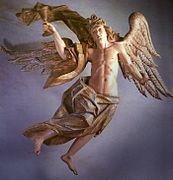








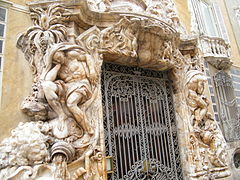


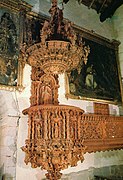





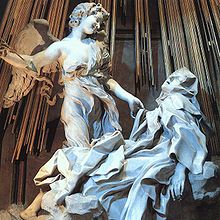





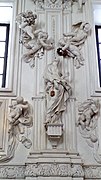
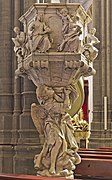


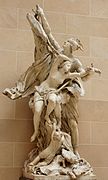


![Cautivos del monumento a Luis XIV en Place des Victoires, de Martin Desjardins (1679)[Nota 8]](https://upload.wikimedia.org/wikipedia/commons/thumb/e/ee/Captifs_Desjardins_Louvre_RF4410_-_1.jpg/240px-Captifs_Desjardins_Louvre_RF4410_-_1.jpg)



![Providentiabrunnen o Donnerbrunnen, fuente en el Neuer Market de Viena, de Georg Raphael Donner (1737-1739)[9]](https://upload.wikimedia.org/wikipedia/commons/thumb/1/1e/Wien_Donnerbrunnen_neuer_Markt.JPG/270px-Wien_Donnerbrunnen_neuer_Markt.JPG)


![Autorretrato de Cosme Damián Asam en la decoración escultórica al estuco de la abadía de Weltenburg (1716-1739)[10]](https://upload.wikimedia.org/wikipedia/commons/thumb/f/ff/Cosmas-Damian-Asam-Weltenburg-2560px.jpg/270px-Cosmas-Damian-Asam-Weltenburg-2560px.jpg)
